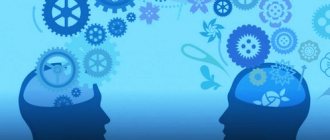Adaptability is a person's ability to adapt to changing circumstances. Adaptability expresses the intellectual qualities of a person, thanks to which the individual is able to change the direction of his thoughts and all his intellectual activity in accordance with the assigned mental tasks and the conditions for their solution.
High adaptability is a property in personality psychology due to which an individual has more opportunities than people with a low degree of adaptability.
High adaptability demonstrates the intellectual ability to vary between the general level of development and convergence.
Adaptability in its meaning is very close to the mobility of intellectual activity. As a personal quality, psychological adaptability contributes to spiritual development, the dynamics of worldview and a change in worldview.
High adaptability is a very useful quality, since a person may not be afraid to find himself in unfamiliar situations or places, because he will quickly begin to navigate them and accept the existing conditions.
Flexibility and adaptability of human actions and reactions often help an individual to survive even in extreme, potentially dangerous situations.
Adaptability occurs at three levels – biological, social and psychological.
At the biological level, adaptability is the ability of a person to maintain his form within the necessary limits for the normal functioning of the body when the conditions of the world change.
Psychological adaptability ensures stable functionality of all brain structures under the influence of external psychological factors.
The flexibility and adaptability of mental processes demonstrate the extent of the development of a person’s natural abilities, helping her to survive under any conditions.
Adaptability at the social level expresses adaptation to the environment through the ability to analyze the social situation, emerging social situations, awareness of one’s own capabilities in the current circumstances, as well as the ability to adapt to the main goals and objectives of the activity.
Factors
The causes of adaptation disorder are emotional and stress factors. They provoke the development of a negative emotional state in which a person is unable to adequately respond to changes in the environment. Such reasons include:
- emotional and psychological abuse;
- difficult life situation caused by sudden changes in external conditions;
- chronic central nervous system disorders;
- somatic diseases;
- prolonged increased mental stress;
- being in a situation of limited resources (lack of sleep, malnutrition).
At risk are people whose living conditions contribute to adaptation disorder: military personnel, medical workers, migrants, elderly people, students.
Four Core Principles of Adaptive Leadership
Below are four core principles of adaptive leadership:
Emotional intellect
Emotional intelligence is the ability to recognize your own feelings and the feelings of others. With this understanding, an adaptive leader is able to build trust with other members and establish strong relationships.
Organizational justice
Another fundamental principle of adaptive leadership is cultivating a culture of integrity. Adaptive leaders know the optimal strategies for the smooth functioning of the organization. They also know the best ways to implement these changes, so people accept them. Adaptive leaders are willing to consider the opinions of other people and thereby convince them that they are important and respected.
Development
Adaptive leadership involves learning new things. If one technique does not produce the desired results, the adaptive leader strives to find new strategies that will work. Thanks to the use of new methods, professional growth and development of employees and the company occurs.
Character
Adaptive leadership involves character—insight and creativity. Adaptive leaders may not always be right, but they are respected by those they work with and do what is recommended.
What is adaptability?
What is adaptability? Adaptability refers to a person’s ability to adapt to changing external conditions. A person cannot remain in the same environment all the time. The first stage when a person is forced to adapt is birth. After comfortable conditions in the womb, the child is now forced to regulate the functioning of his body himself and obey the regime that his parents established.
Adaptation largely depends on a person’s intellectual abilities. The ability to see a situation, find new ways to adapt to it, and the desire to gain new knowledge and experience allow one to adapt. The more a person resists new circumstances, the lower his adaptive ability.
During the adaptive process, it is important how quickly a person develops spiritually, changes his worldview and understanding of the world. If an individual has high flexibility, then he is able to adapt to any conditions
If he finds himself in unfamiliar conditions, then his process of adaptation will be much faster and easier. He won't be afraid because he will be busy adapting and not running away.
Adaptation occurs at three levels:
- Biological – a person’s ability to maintain his health and normal functioning under existing conditions.
- Psychological – the ability to maintain stable and harmonious functioning of the psyche in new conditions.
- Social – a person’s ability to analyze a social situation, realize one’s own capabilities and change in accordance with new tasks and goals.
It is about social adaptability that will be discussed in the article on the website of psychiatric care psymedcare.ru. Because it is the ability to adapt that allows you to remain a mentally healthy individual. Any deviation from the norm is considered maladaptive.
How to develop adaptability
Give up habitual behavioral patterns
Start doing familiar things in a new way. You can start with everyday situations: preparing breakfast, commuting to work, exercising in the gym, cleaning algorithm. Ask yourself: how can this be done differently?
Take risks
Sometimes the risk can be worth it. Of course, you should not expose yourself to serious danger and deliberately deprive yourself of home, family, work, and so on. For example, try increasing the size of the task and reducing the time it takes to complete it. At first glance, this may seem unlikely. But in such a stressful situation, you will begin to think differently and look for new solutions.
Surround yourself with progressive people
Writer Henry Cloud in his book “The Power of Others. Our Environment Determines Us” explains in detail how even strangers can influence our views. Therefore, the more you communicate with open-minded people, the more your picture of the world expands.
Constantly learn new skills
The human brain has a unique feature - flexibility. This, in turn, is ensured through constant development, which is how new behavioral patterns are formed.
Use your browser less often
If you need to find a new address, try to navigate the new place without a GPS to show you the way. Remember the photo of this place, the entrance, be guided by street names and house numbers. This is how you develop spatial thinking.
Adaptation factors
The external environment has many natural factors and factors created by man himself (material and social environment), under their influence personality adaptation is formed.
Natural factors of adaptation: components of wildlife, climatic conditions, cases of natural disasters.
The material environment includes the following adaptation factors: environmental objects; artificial elements (machines, equipment); immediate living environment; work environment.
The social environment has the following adaptation factors: state society, ethnicity, conditions of a modern city, and associated social progress.
The most unfavorable environmental factors are considered to be anthropogenic (technogenic). This is a whole complex of factors that a person needs to adapt to, since he lives in these conditions every day (man-made electromagnetic pollution, the structure of highways, landfills, etc.).
The pace of adaptation relative to the factors described above is individual for each person. Some people can adapt faster, while others find this process very difficult. A person's ability to actively adapt to the environment is called adaptability. Thanks to this property, it is much easier for a person to move, travel, or find himself in extreme conditions.
According to one theory, the success of the adaptation process is influenced by two groups of factors: subjective and environmental. Subjective factors include: demographic characteristics (age and gender) and psychophysiological characteristics of the person.
Environmental factors include: conditions and circumstances of life, nature and mode of activity, conditions of the social environment. Demographic factors, in particular a person’s age, have a two-way influence on the successful adaptation process. If you look from one side, the age of a young person provides him with more opportunities, but in old age these opportunities decrease. But, with age, a person gains experience of adaptation, he finds a “common language” with the external environment.
Another psychological theory identifies four psychological factors in personality adaptation. The cognitive factor includes cognitive abilities and specific features of cognitive processes. The emotional response factor includes features of the emotional sphere. Practical activity is a factor in the conditions and characteristics of an individual’s activity. Personal motivation is a special factor in personal adaptation. For example, if a person’s motivation to achieve success prevails over the motivation to avoid failure, then successful adaptation is formed and key activities become more effective. The nature of adaptation is also influenced by the correspondence of the motivational personal core to the goals and conditions of the activity. Motive is a factor of adaptation and with its help the influence of external circumstances on the individual is mediated.
Description of the technique
The multilevel personality questionnaire (MLI) “Adaptability” was developed by A. G. Maklakov and S. V. Chermyanin (1993). Designed to study the adaptive capabilities of an individual based on the assessment of certain psychophysiological and socio-psychological characteristics that reflect the integral features of mental and social development. The questionnaire has been adopted as a standardized methodology and is recommended for use in solving problems of professional psychological selection, psychological support of educational and professional activities.
The results of MLO testing can be interpreted from the simplest judgments (“pass or fail”) to detailed personal characteristics.
The multilevel personal questionnaire (MLI) “Adaptability” consists of 165 questions and has 4 structural levels, which allows you to obtain information of varying volume and nature.
- Level 1 scales are independent and correspond to the basic SMPI scales (MMPI), they allow you to obtain typological characteristics of a personality and determine character accentuations.
- Level 2 scales correspond to the scales of the DAN questionnaire (“Masadaptation disorders”), designed to identify maladaptation disorders, mainly asthenic and psychotic reactions and conditions.
- Level 3 scales: behavioral regulation (BR}, communicative potential (CP) and moral normativity (MN).
- Level 4 scale - personal adaptation potential (PAP).
How does the process of social adaptation proceed?
According to the structure of the Polish sociologist J. Szczepanski, the adaptation process can be divided into several stages:
- At the initial stage, the individual masters the norms and rules of behavior in society, but at the same time does not yet accept the established system of values and traditions. This may be due to both insufficient familiarity with the ways of the new environment and conscious rejection and denial of its value orientation.
- The second stage is called the “tolerance stage.” During this period, the individual and the environment recognize the equivalence of each other.
- The third stage precedes full entry into the new environment. The process of adaptation begins, reflected in mutual concessions. This means that not only a person recognizes the value system of the host society, but also the members of the social group themselves accept its values and attitudes.
- At the last stage, complete adaptation or assimilation to the conditions and requirements of the new environment occurs. An individual consciously changes patterns of behavior and habitual lifestyle to new attitudes accepted in society.
Social adaptation is a process that is in constant dynamics and accompanies a person throughout his life. Researchers also identify a number of stages in the adaptation of children and adolescents:
- from birth to one year - the child is completely dependent on the adults with whom he constantly interacts;
- from 1 to 3 years - the child begins to copy his family members and use manipulative means;
- from 3 to 6 years - for the first time goes beyond the family social group, discovers and learns new roles, begins to relate himself to one or another family member, whom he consciously imitates;
- from 6 to 10 years - admission to school, the need to adapt to new conditions and people, active intellectual progress, clear manifestation of individual qualities;
- from 10-11 to 14-15 years - active communication and interaction with peers, the formation of self-awareness and the search for individuality; feelings are manifested not only for family and friends, but also for the opposite sex.
Incorrect upbringing can lead to negative consequences and negatively affect a person’s subsequent life. It is during childhood and adolescence that an individual acquires the skills necessary for successful social adaptation and personal development.
The main rule of adaptability
Psychologist Salvatore Maddi and Carl Horn conducted an experiment related to human adaptability. In 1974, Muddy found an article in Family Circle magazine that talked about the need to avoid change, thereby reducing stress. At the time, his own research into creative people showed that original ideas emerged from those in constantly changing environments.
Over the next 12 years, Muddy and his team at the University of Chicago studied employees at the Illinois Bell telephone company. They watched hundreds of people and monitored everything they could: they read blood pressure readings as workers moved from one room to another; watched as one boss left and a new one arrived.
When the company collapsed, six years after his study, about half the people were fired and the other half stayed. Muddy and his team continued to monitor both groups for the next six years.
Most people, whether they kept their jobs or lost them, were unable to cope with the new circumstances. There were divorces, strokes, suicides, kidney failure, heart attacks, alcoholism, drug addiction and compulsive gambling.
But a third of people in both groups did not just survive - they continued to develop. Those who remained at Illinois Bell became leaders in the changed organization. Those who were laid off climbed the career ladder in other companies.
The most amazing thing was how ordinary people were who were able to adapt. On paper, they looked like everyone else, they were not considered smarter, more educated, happier, and did not have any unusual innate abilities. They, according to the psychologist, were distinguished by “existential courage.” While some were trying to get back to normal, reflecting, worrying, a third of the “adaptive” ones took a step forward without asking themselves unnecessary questions.
Roxanne Cohen Silver of the University of California, Irvine found that two out of three grieving widows, victims of terrorism, child abuse and natural disasters will search for meaning in what happened. They are trying to find an explanation for their suffering. For decades, psychologists believed it was a universal response to trauma.
In her research, Silver found that one in three trauma victims will not look for the cause of the incident because it cannot be changed. It is this third that turns out to be the most adapted.
While most Illinois Bell employees searched for a reason for the change, others moved on. When the researchers asked employees about their plans, their vision of the future was largely consistent with the past. They wanted to return to a place that no longer existed.
The people in the adaptive third were different. They also asked themselves what this change meant. But instead of trying to understand why this happened to them, they began to think about how to act now.
What are the principles of adaptability?
What principles is adaptability based on?
- On homeostatic – when a person strives for balance in his external and internal world. No matter what conditions a person lives in, he will always strive to maintain balance and calm. If circumstances change, then the person will change along with them in the direction where he will again feel more or less balanced and calm.
- On the hedonistic level - when a person strives in any situation to get as much pleasure as possible and reduce the amount of suffering, especially to avoid negative emotions. Thus, even in a bad situation, a person wants to find something useful for himself in order to reduce the level of his suffering.
- Pragmatically, when a person wants to expend as little effort as possible, while receiving as much benefit as possible for himself. Man is an inherently lazy creature. Therefore, he is ready to make an absolutely unthinkable decision and consider it correct if it allows him to receive the maximum benefit while spending the minimum amount of effort.
Social adaptability
Social adaptability is understood as the integration of the individual in society, as a result of which self-awareness and roles, self-control and the ability to self-service, and adequate connections with others are formed.
The human adaptive system includes social mechanisms, using which the individual either isolates himself from the influences of the environment or tries to transform this environment for himself so that it corresponds to his full social, biological and personal development.
Adaptability is manifested in a person’s social life, in its everyday actions. When a person changes his place of work, he must adapt to the new team, conditions, corporate rules, leadership style and individual characteristics of colleagues.
Low adaptability significantly affects work efficiency; accordingly, performance may decrease and a person may withdraw into himself and not be able to show his positive qualities. If you analyze the situation, you can choose the appropriate style of behavior and try to adapt to new circumstances.
When a person changes his place of residence, not only an apartment, but even a city or country, it is always stressful. And a person’s well-being, calmness and psychological stability depend only on the ability to adapt.
If it happens that, under the influence of unexpected and inevitable circumstances, an individual’s living conditions change, he may become unsettled. It is in such extreme situations as war, epidemic, natural disasters that a person’s ability to adapt is tested.
People's high adaptability helps them cope with stress faster and accept the current situation as inevitable. Also, people with good adaptability can help people cope with their experiences and adapt to the situation.
When a person's family status changes, this affects the change in his social status. The following situations are particularly stressful: marriage and divorce. In both situations, a person must be able to adapt to the fact that the previously familiar way of life will change.
Social adaptability of a person expresses his active adaptation to the social environment. Specific social adaptability of an individual is of two types. A deviant appearance is a way of a person’s adaptation to social circumstances, violating the values and rules of behavior accepted in society. Pathological adaptability is an individual’s adaptation to social conditions using pathological forms of behavior resulting from mental disorders.
Adaptability is a property due to which the functioning of regulatory mechanisms in society occurs. The more complex the system of civilization in its functional meaning, the more developed its elements and subsystems, the stronger will be the need for effective means to smooth out the contradictions that arise when the interests of the whole and its elements collide. In such situations, certain processes arise. Society requires its subsystems to adapt to the circumstances necessary for the development of civilization. Individuals, their groups and various communities are adapters and are required to adapt their behavior to the needs and interests of the civilizational system.
Law acts as a normative mechanism and carries out the adaptation of society and social objects (individuals, groups) to each other. Its task is to balance and bring into functional harmony the antagonistic forces within a single civilizational system. The purpose of law is to find compromises, mutually acceptable solutions that ensure dynamic balance, and these solutions should allow the system to be a single cooperative whole that solves important common social problems.
Law determines that social actors must behave law-abidingly, normatively and adapted to the general civilizational context. Law is a type of adaptive mechanism due to the fact that it has norms and laws as effective means of adapting behavior to social conditions.
Exercises to develop flexibility of thinking
How to develop a flexible mind? Although some people have an innate ability for flexible thinking, anyone with awareness and practice can access it.
Here are some ways to develop flexible thinking:
Not only will these tips help you exercise your brain, they will make you feel stronger and more creative, setting you on the right path to achieving your highest goals.
Who is flexible, listens, analyzes, appreciates and adapts, trying to give their best for their goal, without forgetting the needs of others.
Mental flexibility is not arbitrary or whimsical, but is based on our goals and aspirations, and the balance between control and spontaneity. When we are mentally flexible, we pursue goals knowing that those goals can sometimes be changed or modified as we learn more about situations and our ability to achieve the impossible.
Natalia Shakhova
Signs of social maladjustment
Attention! Despite the complex work of socialization institutions, social adaptation is not always a natural result of the process of growing up. Sometimes a child, having become an adult, from a pedagogical point of view, remains socially unadapted
Signs of unsuccessful completion of the socialization and adaptation program are:
- A person has poor knowledge of the laws of functioning of the market and the socio-economic sphere;
- An individual cannot decide on the choice of profession, remaining unemployed for a long time, despite having a professional education;
- A person takes an illegal path, acts as a person organizing crimes, and serves time in prison.
Attention! Disabled and elderly people cannot be considered socially maladapted. At one time they were successful in the social environment
Disabled people cannot perform certain functions, but this does not mean that they cannot undergo rehabilitation.
Career growth mindset
This desire of a candidate for a vacant position in 2022 will attract company leaders: drive and curiosity are welcomed at all times, especially such difficult ones as the current one. Many business leaders admit that they would prefer an applicant who wants to learn over someone who has excellent technical skills but is not committed to improving their skills. As our lives change, so must our working style.
Trends, new clients: why does a company need rebranding and when does it need it?
Cancers are looking for a calling: how Mercury retrograde affects the careers of zodiac signs
It's never too late to learn new things: why it's not a shame to be an intern in adulthood
Principles of adaptability in psychology
Psychology views every person as a being who is prone to adaptation. There are three principles of adaptability in psychology:
- Homeostatic. This concept assumes that the human body is programmed for only one goal - maintaining balance in the existing conditions. Wherever a person is, his body will look for those options where he can be calm and healthy and function. At the psychological level, a person strives to restore balance with himself and with the world around him by accepting himself, despite the interference and help of society.
- Hedonistic. In this concept, a person proceeds from the principles of satisfying his desires. Whatever environment he finds himself in, all his actions will be aimed at satisfaction or benefit. At the same time, there are cases of self-sacrifice or heroism, as well as situations when a person acts in the interests of society, an entire group, and not himself (for example, at work).
- Pragmatic. This concept views man as a rational and logical being. Here a person acts based on the desire to achieve maximum effect or result through the application of minimal effort. The most interesting thing is that a person perceives even not the most reasonable ideas as logical if they help him achieve his goal.
If you are careful, you will notice that first a goal arises, to which a person already submits. The goals are:
- Self-preservation, survival, health, harmony.
- Satisfaction and feeling of happiness.
- Achieved goals with minimal effort.
All these directions are implemented by people in the conditions of the surrounding world, which dictates its own rules and norms. If a person lives according to the principles established in society, then achieving goals will be easy for him, although not always effective. If a person sets individual goals that in some sense do not correspond to social ones, then he will be forced to look for unknown ways to achieve them. Society will either hinder or help in this case.
§ 1. 2. Principles of construction and organization of intelligent systems
The study of information systems makes it possible to make an attempt to formulate general principles, which, although not sufficient, reflect the necessary aspects in their organization and functioning.
paragraph 1. 2. 1. The principle of consistency.
IS can only be complex systems; the functions of all their elements must be consistent with the purpose of the system and their place in them, as well as with each other. It is the mutual consistency and interdependence of system elements that ensures the integrity and functional completeness of the most advanced IS. It may also lead to structural or functional redundancy.
paragraph 1. 2. 2. The principle of hierarchy.
A complex hierarchical multi-level structure is the basis for the simultaneous occurrence of many processes. The level of originality of the final process depends on the nature of the totality of the constituent processes. A complex set of processes is fundamentally characterized by a complex structure. Thus, in some way, the level of complexity of a system and its structure determines the potential level of its intelligence.
paragraph 1. 2. 3. The principle of multi-channel.
Obtaining solutions to various problems that are consistent with the circumstances and environment is based on information received from the outside through many channels and working on various physical principles, which makes it possible to have a heterogeneous characteristic of the special properties of environmental objects. Integrating information data allows you to have a more objective and more complete picture of ongoing processes. Heterogeneous information received through different channels is processed in approximately the same minimum possible time.
The clarity of this principle is characterized by the following fact. A person is capable of solving various types of identification problems in a fraction of a second, and the human visual system undoubtedly works as a parallel device. Parallel processing of both visual information and that entering the human brain from other senses allows for invariant recognition of objects.
paragraph 1. 2. 4. The principle of adaptability.
The principle of adaptability assumes that the IS has the potential to improve its performance: under conditions of a priori and current uncertainty based on learning from experience.
A special role in this case belongs to the elements of the system that implement memory.
Adaptation can occur through self-tuning, self-learning, or self-organization. Adaptive abilities can be determined by the amount of information (memory) of the system and the time required to process it.
paragraph 1. 2. 5. The principle of reciprocity of functional and structural properties.
Naturally, the purpose of the system and its functions directly affect the structure of the system. However, the structure of the system should contribute to the most complete
implementation of functions.
clause 1. 2. 6. The principle of equivalence.
This principle assumes that the system has many mutually agreed upon sequences of reactions to certain external influences, leading to the same practically useful result.
paragraph 1. 2. 7. The principle of dynamic self-programming.
The most remarkable feature of nervous control, most clearly expressed in the purposeful creative mind of a person, is the ability, based on a diverse analysis of situations, to instantly create the most complex and at the same time optimal programs of activity, which are continuously rebuilt and adjusted taking into account past events, current reality and forecasting the future. Already the formation of an elementary conditioned reflex represents the development of a new behavior program. The increasing complexity of conditioned reflexes means increasingly higher self-organization of behavioral programs. In the cybernetic sense, the main function of higher nervous activity is the dynamic behavior of self-programming.
Content
- 1 Description of the technique
- 2 Theoretical foundations
- 3 Procedure 3.1 Instructions
- 4.1 Level 3 and 4 scales
- 4.8.1 “Keys” to the basic SMIL scales in the MLO “Adaptability” method (1st level scales)
- 5.1 Questionnaire text
Interview Questions
Has your organization made changes that you did not agree with? When and why did you accept these changes?
Organizational policies sometimes change. Have you experienced similar changes? How did you react to this?
What difficulties did you encounter when changing jobs? Describe the process of your personal changes?
Organizations tend to evolve. Could you describe how your position has changed? How did you deal with this?
Could you describe a recent situation in which you had to adjust your plan or reconsider your priorities? In what context and what exactly did you do? What adjustments did you make and how did you implement them? What was it difficult for you to give up?
What is mental flexibility?
Flexible thinking is part of a group of skills called executive function. Problems with these skills are common in children with ADHD (attention deficit hyperactivity disorder). But other children and adults who think and learn differently may also have difficulties with flexible thinking and executive function.
Flexible thinking, also known as cognitive flexibility, is the ability to think about something in more than one way.
To be flexible is to create, explore, generate, imagine, improvise, invent, change, relate, transform and adapt. It is not a decision to change, even if it is inconvenient, but an action when it is necessary.
In contrast, an inflexible person is a slave to his circumstances and his ironclad statements, unable to cope with change with an adaptive attitude, and is unlikely to be completely happy since everything around him cannot revolve around his particular norm. This inflexibility can cause problems at work and in your personal environment, but also, and most importantly, in your relationship with yourself.
Characteristics of adaptive sports
• Adaptive sport is a component (type) of RFC that satisfies
personality needs for self-actualization, to the maximum
https://www.youtube.com/watch?v=ytpressru
possible self-realization of one’s abilities, comparing them
with the abilities of other people; communication needs
activities and socialization (S.P. Evseev).
• Sports for the disabled (adaptive sports) - a type of sports
activities aimed at social adaptation and
physical rehabilitation of disabled people and persons with limited
health opportunities. Development of sports for disabled people and persons with disabilities
is based on the principles of priority, mass
distribution and accessibility of sports (RF Law “On
physical culture and sports in the Russian Federation")
BENEFITS OF ACTIVITIES IN ADAPTIVE SPORTS
Adaptive sports significantly contribute to the integration of disabled people into
social life. It allows you to engage in social contacts with
other people: athletes, coaches, doctors, etc.
2. In the process of playing sports, a disabled person gets the opportunity to
self-realization, self-improvement, self-affirmation,
self-determination.
3. Adaptive sports can act as a means of achieving perfect
• A means of self-affirmation, with the desire for leadership and victory.
• A way to improve health, correct motor functions, improve
well-being.
• A means of social and psychological adaptation and rehabilitation
(expanding your social circle, combating shyness, etc.).
• Sport as a hard professional activity, the main way of earning
material resources.
Directions of adaptive sports
Paralympic sport
Special Olympics
Deaflympic sport
Adaptive modernization
Responsive redesign is a process that takes an existing desktop-only website and essentially “remakes it responsive.”
For most organizations, large-scale creation of a new design from scratch is not even considered. This is why responsive modernization is a popular approach to creating a good experience for mobile devices.
Advantages
- Relatively fast. There are quite a few ways to do responsive modernization, this strategy could be adding a small-screens.css file to the site. Despite this rather crude example, adaptive modernization is an attractive option for a large number of organizations because it does not require rebuilding everything from scratch.
- Familiar. Doesn't confuse users. People have spent years getting used to the interface, and by modernizing the existing one, organizations maintain a familiar approach while improving the lives of people with mobile devices.
- Organizationally faster. Politically speaking, modernizing the interface is safer than starting from scratch. There will be less debate about what shade of green to choose, what trivial stock photos to use, and management will not have to twist their arms. This allows teams to launch responsive sites faster.
Flaws
- Only affects a small part. Again, there are many options for doing a remodel, but the goal of most of them is to “make it pretty.” By focusing on redesigning the layout, redesigns often miss the myriad of other factors that need to be considered when creating a successful design for a variety of devices.
- 10 liters of water in a three-liter jar. Since desktop sites are designed only for desktop computers (and often last for a long time), they can contain a lot of clutter. And since modernization mainly consists of re-melting the layout, most problems with content are not fully taken into account.
- Performance. There's something strange about writing code to better support small devices. Removing unnecessary stuff can go too far, but without focusing on productivity, it won't grow on its own.
- Worst support. Media queries, originally designed for desktop computers, are poorly supported on most mobile devices.
- Temporary fixes. I feel like dying when I hear people asking me to “make responsive” something, as if it were just a checkbox in the project plan (which sometimes it actually is). This type of limited thinking misses the real opportunities that responsive design offers.
Survival Skills
Whether it's adaptability, endurance, or something else, survival skills have earned a place at the top of our list. Companies will be interested in people who have experienced failure but were able to persevere despite obstacles and failures. Determination and the desire to succeed, no matter what, will be especially important.
Location matters: why some people can't find work
The price of secondary housing in Sevastopol has reached 150 thousand rubles per square
Feel free to offer your help: How to make friends at your new job
Theoretical basis
The theoretical basis of the test is the idea of adaptation as a constant process of an individual’s active adaptation to the conditions of the social environment, affecting all levels of human functioning. The effectiveness of adaptation largely depends on both the genetically determined properties of the nervous system and the conditions of upbringing, learned behavioral stereotypes, and the adequacy of the individual’s self-esteem. A distorted or underdeveloped self-image leads to adaptation disorders, which may be accompanied by increased conflict, misunderstanding of one’s social role, and deterioration in health. Cases of profound adaptation disorders can lead to the development of diseases, disruptions in educational and professional activities, and antisocial behavior. The adaptation process is extremely dynamic. Its success largely depends on a number of objective and subjective conditions, functional state, social experience, life attitude, etc. Each person has a different attitude towards the same events, and the same influencing stimulus can cause different response. It is possible to identify a certain interval of an individual’s responses, which will correspond to the idea of a mental norm, and it is also possible to determine a certain “interval” of a person’s relationship to a particular phenomenon, relating, first of all, to the categories of universal human values, which does not go beyond the framework of generally accepted moral norms. The degree of compliance with this “interval” of mental and socio-moral normativity ensures the effectiveness of the process of socio-psychological adaptation and determines personal adaptation potential (PAP), which is the most important integrative characteristic of mental development. Characteristics of personal adaptation potential can be obtained by assessing behavioral regulation, communication abilities and the level of moral normativity.
Behavioral regulation (BR)
is a concept that characterizes a person’s ability to regulate his interaction with the environment of activity. The main elements of behavioral regulation are: self-esteem, the level of neuropsychic stability, as well as the presence of social approval (social support) from surrounding people. All the highlighted structural elements are not the fundamental basis for the regulation of behavior. They only reflect the relationship between needs, motives, emotional background, mood, self-awareness, “I-concept”, etc. The regulation system is a complex, hierarchical formation, and the integration of all its levels into a single complex ensures the stability of the process of behavior regulation.
Communication qualities (communicative potential - CP)
is the next component of personal adaptation potential (PAP). Since a person is almost always in a social environment, his activities involve the ability to build relationships with other people. Communication capabilities (or the ability to achieve contact and mutual understanding with others) are different for each person. They are determined by the presence of experience and the need for communication, as well as the level of conflict.
Moral normativity (MN)
provides the ability for an individual to adequately perceive the specific social role offered to him. In this test, questions characterizing the level of moral normativity of an individual reflect two main components of the socialization process: perception of moral standards and attitude to the requirements of the immediate social environment.
Will and personality adaptability
The question of the relationship between will and personality is the question of what place will occupies in the structure of personality, how it is connected with other characteristics of a person as a person, to what extent it determines the development of a person as a person and, accordingly, his life successes. There are concepts of “strong-willed personality” and “weak-willed personality.” A strong-willed personality is understood as a person who has a highly developed will and manifests it, if not in all, then in many life situations and activities. A weak-willed person is a person who does not have great willpower or does not show it in what he should have shown.
Characterizing a person as a strong-willed or weak-willed person is not an abstract psychological division of people into categories, but an essential characteristic. It determines the real existence and manifestation of other positive or negative personal properties in a given person. It is assumed that a strong-willed personality has many other valuable features, such as, for example, highly developed consciousness, intelligence, abilities, and moral qualities. In addition, more significant achievements in various types of activities are expected from a person with a highly developed will than from a person with an undeveloped or underdeveloped will. If a person is characterized as weak-willed, then at the same time other, mainly negative, psychological properties are attributed to the person, for example, a relatively low level of intellectual development, underdeveloped abilities, insufficiently strong motivation for activity and failures in life.
A person’s will is closely related to many of his other psychological characteristics. Let's look at some of them. Will primarily manifests itself in such personality traits as energy, perseverance and endurance. These properties can be considered as basic or primary volitional qualities of a person. Along with them, there are secondary volitional qualities, which include consciousness, responsibility and determination. A strong-willed person is characterized by determination, courage, self-control and self-confidence. Such qualities in a person are usually formed and developed later than the above-mentioned group of primary personal qualities. Volitional qualities manifest themselves together with a person’s character, so they can be considered not only as volitional, but also as characterological.
There is a group of volitional qualities associated with a person’s morality and value orientations. They, accordingly, can be called moral and value-based volitional properties. These include integrity, honesty and responsibility. These qualities are mainly manifested in a person’s attitude to his responsibilities and in relationships with other people. This group of personal properties also includes those volitional qualities that are manifested in activities with inanimate objects, for example, perseverance, efficiency and initiative.
Among the general volitional qualities of a person one can name willpower, endurance and self-control, determination, perseverance, independence, determination, consistency, restraint, and self-control. Thus, the will or volitional qualities of a person include many individual characteristics of a person, which at the same time are part of his character under the name “volitional character traits.” Since, as we already know, character occupies a central place in a person’s personality, the same assessment can be transferred to a person’s will: it also occupies one of the main places in a person’s personality.
There are many examples of how people, thanks to their will, achieved significant success in life, although at the beginning of their life they had neither highly developed abilities (inclinations) nor the opportunity to achieve success. When discussing the issue of its formation and development in the “character” chapter, we stated that of the three main groups of character traits - strong-willed, business and communicative - strong-willed are among the first to begin to form and develop. On their basis, other character traits are subsequently formed and developed. This fact especially emphasizes the importance of will not only in terms of ensuring the success of a person’s activities, but also from the point of view of his development as an individual.
Adaptability is usually understood as the presence of certain individual characteristics that allow an individual to most quickly and adequately resolve problematic situations, normalizing his interaction with the environment.
One of the central problems in researching the adaptive potential of an individual is the mosaic nature of the data obtained and the difficulty of reconciling the results described by different authors. Huge amounts of empirical data accumulated to date do not allow us to come to any unambiguous conclusion regarding the composition of qualities that can be interpreted as adaptive.
The objective reasons for this diversity can be identified:
1. Relativity of adaptive qualities.
The concept of the relativity of adaptive qualities was introduced by Charles Darwin: adaptations that are useful in some conditions become useless or even harmful in others. In the context of socio-psychological adaptation, the relativity of adaptive qualities manifests itself most clearly and can be determined by the characteristics of adaptive processes occurring in different conditions, as well as reflect the specifics of interaction with the social environment at different levels (micro-, meso-, macro-). For example, there is no doubt that adapting to a new professional activity and building interaction in a family or in a study group requires different adaptive abilities.
To achieve certainty, it is necessary to identify the conditions in which a particular quality or model of behavior will be most adequate and effective, or to classify as adaptive only generalized, integral characteristics that could be more or less universal.
Among the integral characteristics, the most often mentioned are: tolerance, flexibility of thinking and behavior. In all likelihood, these traits represent some of the basic units that are valuable for any type of social adaptation. However, it cannot be argued that this list claims to be complete and complete.
2. Individualization of adaptation methods and styles.
The qualitative diversity of adaptation methods in many cases makes it impractical to identify specific elements that have adaptive significance. An attempt to solve this problem was implemented by replacing the substrate approach (emphasizing the qualitative composition of adaptation) with a structural one (considering the organization of elements in the system).
The main argument was the following: various adaptation factors act independently of each other, giving a certain overall effect, but form a certain structure with a complex relationship. Some of them can strengthen or, conversely, weaken the influence of others. Therefore, it was suggested that it is the integrity, integration and compensation of personal properties that can serve as the basis for adaptation.
It was found that the structure of personality traits in highly adapted subjects is more integrated than in subjects with poor adaptation. There is evidence that the latter have a more uneven personality structure: a number of peaks indicating decompensation of personal properties, while their personality profile is less harmonious and internally contradictory.
Thus, the problem of diversity and mosaic of adaptive characteristics has given rise to two methodological approaches aimed at resolving it:
1) search for generalized, “core” adaptive characteristics;
2) analysis of the personality structure from the point of view of its organization.
How was the empirical data obtained?
The traditional approach to the study of adaptive personality traits is that groups of adapted and maladapted individuals are experimentally compared. Significant differences between the first group and the second are taken as adaptive properties.
Flaws:
1. The final result of such a study largely depends on the choice of initial means. Here there is an uncertainty in the field of choice of variables that will be analyzed, the fundamental unlimitedness of the characteristics, the randomness of the choice and its susceptibility to the subjective views of the author.
2. Technology based on the comparison of features characterizing the extreme points of the process (here adaptation and maladaptation) does not take into account the fact that some adaptive qualities can be activated precisely during the adaptation process and remain in a latent state in well-adapted individuals. Therefore, many traits of adapted individuals, isolated as a result of an empirical procedure, may well be a consequence of their fitness, and not a cause.
To solve this problem it is necessary:
— Firstly, the theoretical limitation of the field of initial parameters;
— Secondly, taking into account the procedural side of the adaptation phenomenon.
Adaptation goals:
The adaptation process is classified as a directed process. Such processes for the most part tend to constantly move towards a certain final goal or state. It is no coincidence that the idea of teleology (purposefulness, expediency), repeatedly criticized, nevertheless accompanied the problem of adaptation from the very beginning of its development.
The need for adaptation arises when there are some disturbances in the interaction between the individual and the environment. And, naturally, the process caused by this naturally pursues the goal of eliminating existing violations and optimizing interaction.
It is noteworthy that in the overwhelming majority of cases, it is through the final goal of the process that its definition is given. For example, the most common definitions are: adaptation is a process:
— Devices...,
— Transformations of the environment...,
- Useful changes...,
— Keeping variables within normal limits...,
- Balancing, balancing the internal with the external...,
— Increasing the level of functioning... etc.
As a rule, the interpretation of the goal reflects an understanding of the essence of the adaptation process itself and, accordingly, the state of adaptation.
If we analyze the entire arsenal of goals proposed by different authors, then, assuming a certain level of generalization, they can be organized into a hierarchical sequence:
- adaptation - maintaining variables within normal limits - balancing, coordination - achieving an above-standard state, increasing the level of functioning - self-realization.
As you move from level to level, the factor of individual activity and individualization increases, a preponderance of significance appears in the direction of the individual, and the difficulty of achieving a result increases.
The goal of adaptation is associated with a certain final state towards which the system strives. In general, the adaptation process is aimed at transitioning the system from some initial (unsatisfactory) state to another, final (more acceptable) state.
The need for adaptation arises most acutely when an individual is below the lower limit of the norm, the symptoms of which are psycho-emotional stress or deviations in behavior. Further progression of this condition can lead either to the destruction (illness, death) of the individual as a result of adverse environmental influences, or to the destruction of the environment interacting with him as a result of the individual’s destructive actions. In this case, the final adaptive state will be, first of all, a state that ensures normal life activity and brings the individual in accordance with regulatory requirements and expectations.
However, unlike a biological organism, a person may not be satisfied with such a state of stable equilibrium. It is no coincidence that the idea of stable equilibrium has been repeatedly criticized. As an alternative opinion, arguments were given in favor of the fact that a person has a tendency to disturb balance, associated with the search for new sensations, impressions, testing one’s capabilities, and the desire to go beyond the limits of one’s self. The desire for achievement, the need for self-expression can stimulate further development of the process , the end result of which will now be some excess state. When focusing on an internal criterion, we are talking about the realization of individual aspirations and self-expression; when focusing on an external criterion, we are talking about socially useful activity and efficiency. Coordination of the two above-normative states allows one to reach the level of self-realization, which is the highest stage of the adaptation process.
The optimal form of adaptation is closely related to the concept of self-realization, which is especially important for social adaptation. Self-realization, in contrast to self-expression, is possible only in contact with real society, in the process of productive interaction between the individual and the environment. It is the finding of a socially approved, productive and socially useful way of actualizing and expressing the internal potential of the individual that determines self-realization as the highest form of adaptation.
The driving force that allows one to strive for a new state is a certain motive.
Motive is a conscious need, motivation for activity related to satisfying the needs of the subject; a set of external or internal conditions that cause the subject’s activity and determine its direction.
Also, a motive can be an object, material or ideal, that motivates and determines the choice of direction of activity, for the sake of which it is carried out, and a conscious reason underlying the choice of actions and actions of an individual.
— A motive is born in the act of objectifying a need and is defined as an object of need.
— A typical sign of a motive is a multitude of actions that gather around one object.
— In terms of their role, not all motives that encourage a certain activity are equivalent: one of them, the main one, is called the leading motive, the secondary ones are called incentive motives.
— Motives are not always conscious, and therefore they need to be divided into two large classes: conscious motives and unconscious motives.
— Motives form a hierarchical structure.
The main motives pursued by an individual in the process of adaptation can also be arranged in the form of a hierarchical sequence: avoiding destruction - maintaining normal functioning - achieving a possible optimum - development and improvement.
- Psychology and human values
- “My certificate on an ancient medium”
- Data Mining Technologies
- Concept, characteristics and functions of the state
- Basics of family law
- Mental properties of personality
- Types of tactical defensive operations
- Covering up competitors
- Competitive Counterintelligence Operations
- Impact of the COVID-19 epidemic on the global economy
- The role and place of Russia in the world historical process
- Corruption
Examples of behavior:
General
- ready to change your routine
- is not tough
- does not hesitate to adapt, giving up his individuality
Operational
- adapts its methods when required
- does not require a lot of time to adapt to a new task
- continues to work effectively when tasks suddenly change
- easily adapts to new working conditions with different rules
- easily switches to other standards and values
Tactical
- easily adapts to different tasks and requirements after a merger or acquisition
- able to develop professional relationships with colleagues and clients from different cultures, religions and personalities
- adjusts his plans and goals if it is beneficial
- brings his style of behavior to a certain norm in another environment; tries not to stand out
- easily adapts plans and diagrams when necessary
Strategic
- follows the rules and beliefs appropriate to his/her new position, both inside and outside the organization
- acts in accordance with cultural characteristics and follows established rules
- adjusts own opinions and goals to achieve common goals
- open to different norms, values and rules, without losing a sense of identity
- easily identifies important cultural components in various situations and contexts and acts in accordance with them
Goal-oriented
Many managers report that they are looking for goal-oriented people to join their teams. As markets change and customers strive to adapt to the new normal, company leadership wants teams to help and educate others, thereby creating an effective and cohesive team.
Losing potential employees: why you shouldn’t scold interns at work
The Russians told what qualities are most annoying in leaders
Profit without competitors: is it worth opening a mini-dairy and what are its features?











